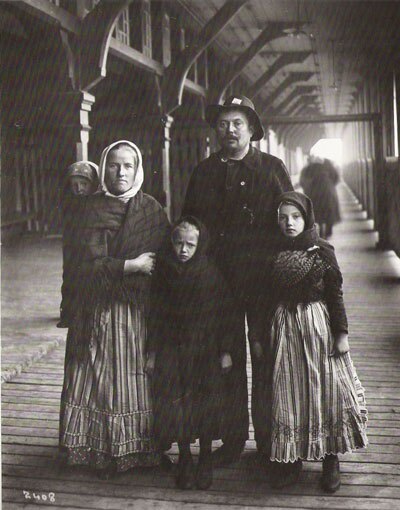Aller Anfang ist schwer is a German proverb meaning "all beginnings are hard." This must have been true for the millions of German immigrants who left their homeland for a new country, as well as for the people who made their way to Germany to settle there and call it home.
As you search for your family members with German heritage, knowing the history of German immigration (people coming to the country) and German emigration (people leaving the country) can help you in your search.
Influences on German Immigration: The Revolution of 1848

Big changes were happening in Central Europe in the 1800s, including a lack of unity within the German states which led to several changes in government and civil unrest. Following the example of the February 1848 revolution in Paris, frustrated German citizens took matters into their own hands. Riots broke out in urban areas with people fighting for freedom of the press, trial by jury, a fairer system of taxation, and freedom of religion.
The Revolution of 1848 was seemingly successful in uniting the German State, but by the autumn of 1849, it became clear that the new government had not yet established true unity. This disappointment led to a mass exodus of Germans in search of a new life in another country.
German Emigration after the Revolution of 1848
An estimated 6 million emigrants left Germany between 1820 and 1920 because of the failed revolution, additional political strife, religious conflicts, famines, and a lack of opportunities.
While Germans traveled to many different countries throughout the world during this time, the top 4 countries with German ancestry today include the following:
- The United States of America (estimated 46.8 million people with German ancestry)
- Brazil (estimated 12 million people with German ancestry)
- Argentina (estimated 3.5 million people with German ancestry)
- Canada (estimated 3.2 million people with German ancestry)
German Immigration to America
About 90% of German emigrants who left Germany after the revolution chose to make the United States their new home. However, Germans had already been coming to America decades before in search of religious freedom. In 1608, Germans helped establish the Jamestown settlement, as well as New Amsterdam in 1620. By the 1700s, Germans made up one-third of the population of the American colonies, and the German language was spoken in almost every city.
German farmers moved out west and were among the first to cultivate oranges. Skilled German workers used their urban craft trades to create new businesses. Some of those businesses included Rockefeller (petroleum), Studebaker and Chrysler (cars), and H.J. Heinz (food).
Germans Immigrants in Brazil

Although the majority of German emigrants made their way to the United States in the mid-1800s, a number of them traveled to South America and established a strong community there.
Germans who came to Brazil mostly settled in the Southern region, with the cities of Blumenau and Joinville soon becoming the most popular colonies for German immigrants. With an estimated 260,000 Germans coming to Brazil between 1824 and 1972, German influence in the area continued to grow.
Another reason for the strong German heritage in Brazil has to do with the high birthrate of the German Brazilian women. Between 1826 and 1828, first-generation German Brazilian women had an average of 8 children, and the second-generation women had an average of 10 children.
German Immigrants in Argentina
In terms of German immigration to South America, those who didn’t settle in Brazil made their way to Argentina.
The two largest years of German immigration to Argentina were 1923 and 1924, with about 10,000 immigrants each year. Rural German communities started to grow in the Buenos Aires Province, Entre Rios Province, La Pampa Province, Misiones Province, and Córdoba Province.
In addition to becoming a new home for former German citizens, Argentina became known as a haven for members of the Nazi Party. After the end of World War II, Argentine President Juan Perón ordered the creation of secret escape routes called “ratlines” to smuggle thousands of former SS officers and Nazi party members out of Europe.
German Immigrants in Canada

Even before the Revolution of 1848 in Germany, the United States wasn’t the only place in North America with a history of German immigration. Britain contracted soldiers from the German states to come and help suppress the American Revolution. After the war, many of those soldiers settled in Canada, had families, and became part of the community.
Before the Second World War, Germans were drawn to Canada for several reasons, including religious freedom, cheap and abundant farmland, and business opportunities. By the 1950s and 1960s, Germans were seeing more and more financial success and were earning income that matched or surpassed those of English and French Canadians.
German immigration in Canada influenced the formation of secular social clubs to strengthen their community. Some of these included the Halifax High German Society, Trans-Canada Alliance of German-Canadians (and its successor, the German-Canadian Congress), and the German Society of Montreal.
Back on the Road to Unification
Let’s take a step back to see what happened in Germany after the Revolution of 1848. The massive emigration of 6 million Germans caused the population to drop significantly. During the following decades, there were many wars and attempts to unify the German states. On January 18, 1871, Prussian King Wilhelm I managed to finally succeed in establishing German unification and proclaimed himself the emperor of the new nation state of Germany.
Immigrants Coming to Germany
During this time of unification, Germany was also facing another type of revolution: the Industrial Revolution. With the huge population loss in 1848, along with the rise of the industrial era beginning in 1890, Germany was in need of workers. The promise of work and a fresh start brought excitement and immigrants to the country. In fact, the number of people immigrating from neighboring countries to Germany surpassed the number of Germans who left. Most of the new immigrants worked in the coal and steel industries.

Germany has been a desirable place for immigrants ever since. In fact, the Germany’s Federal Statistics Office stated that "some 18.9 million people, or 23% of Germany’s population, either immigrated to the country since 1950 or are the children of immigrants." If you’re interested in moving to Germany, here is a helpful guide to help you get started.
Your German Ancestry
Whether your German heritage comes from a German emigrant who left Germany or an immigrant who came to Germany, you come from a rich culture that can be found throughout the world.
On the FamilySearch website, not only can you search for historical records of your German ancestors, but you can also preserve the memories you have of them. Do you have a photo of your great-grandfather in his traditional Lederhosen? Or maybe you have your aunt's recipe for Schwarzwälder Kirschtorte (Black Forest cake)? You can upload photos and record accompanying audio by using the FamilySearch website or the Memories app
Learn More about Your German Heritage
At FamilySearch, we care about connecting you with your family, and we provide fun discovery experiences and family history services for free. Why? Because we cherish families and believe that connecting generations can improve our lives now and forever. We are a nonprofit organization sponsored by The Church of Jesus Christ of Latter-day Saints. To learn more about our beliefs, click here.




